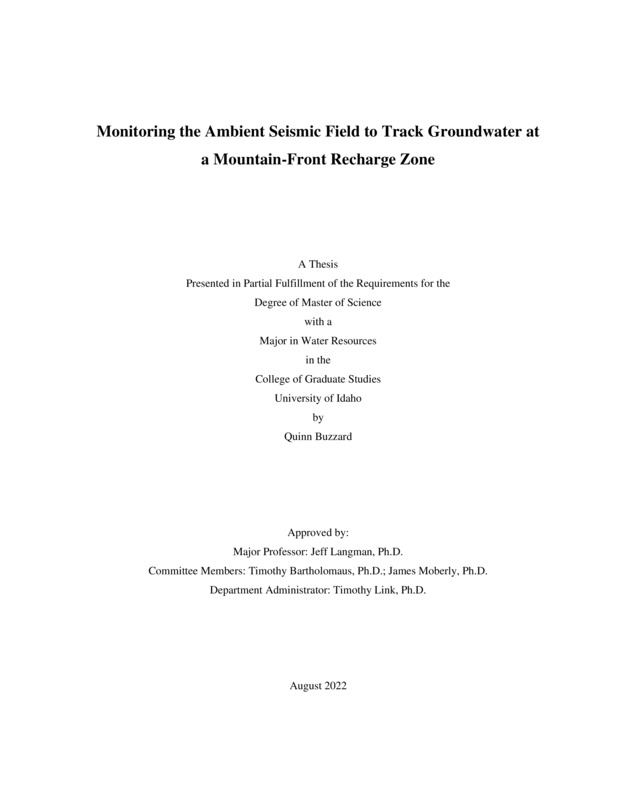Monitoring the Ambient Seismic Field to Track Groundwater at a Mountain-Front Recharge Zone
Buzzard, Quinn Alexander. (2022-08). Monitoring the Ambient Seismic Field to Track Groundwater at a Mountain-Front Recharge Zone. Theses and Dissertations Collection, University of Idaho Library Digital Collections. https://www.lib.uidaho.edu/digital/etd/items/buzzard_idaho_0089n_12457.html
- Title:
- Monitoring the Ambient Seismic Field to Track Groundwater at a Mountain-Front Recharge Zone
- Author:
- Buzzard, Quinn Alexander
- ORCID:
- 0000-0002-7389-1006
- Date:
- 2022-08
- Keywords:
- Groundwater Recharge Seismology
- Program:
- Water Resources
- Subject Category:
- Water resources management; Geophysics
- Abstract:
-
The heterogeneity of the fractured-basalt and interbedded-sediment aquifer along the eastern margin of the Columbia Plateau Regional Aquifer System has presented challenges to resource managers for quantifying recharge. Previous studies indicated recharge pathways in alluvial sediments atop a mountain-front interface upgradient of the basalt flows. In this sedimentary zone, six seismic stations were deployed for one year to detect low-frequency seismic waves that could be correlated to changes in groundwater recorded by a well transducer near the center of the seismic station network. Sufficient waveforms were recorded at each station to determine changes in wave velocities between station pairs and correlate these changes to groundwater levels. The velocity-groundwater relation at each station pair allowed for estimation of daily groundwater flux beneath the seismic station network. Existing hydrogeologic information was used to estimate hydraulic gradients and hydraulic conductivities, which allowed for calculation of the daily volume of recharge passing beneath the seismic stations and into the confined aquifer system. The daily recharge volumes across the seismic station network were summed for comparison of the total annual recharge calculated from the seismic wave velocities (154,660 m3) to a flow model calculation of recharge based on areal precipitation and infiltration/percolation to the area upgradient of the seismic station network (26,250 m3). The 6× greater recharge estimated from the seismic velocity changes for this portion of the recharge zone is attributed to preferential pathways of high hydraulic conductivity and greater depth associated with paleochannels beneath the seismic station network.
- Description:
- masters, M.S., Water Resources -- University of Idaho - College of Graduate Studies, 2022-08
- Major Professor:
- Langman, Jeff
- Committee:
- Moberly, James; Bartholomaus, Tim; Link, Tim
- Defense Date:
- 2022-08
- Identifier:
- Buzzard_idaho_0089N_12457
- Type:
- Text
- Format Original:
- Format:
- application/pdf
- Rights:
- In Copyright - Educational Use Permitted. For more information, please contact University of Idaho Library Special Collections and Archives Department at libspec@uidaho.edu.
- Standardized Rights:
- http://rightsstatements.org/vocab/InC-EDU/1.0/

